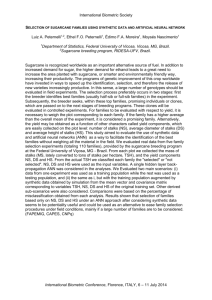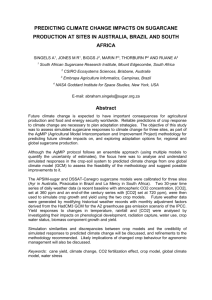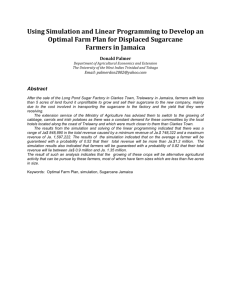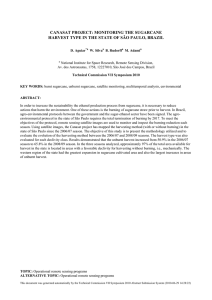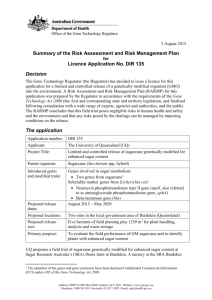Asian Journal of Agricultural Sciences 4(1): 32-39, 2012 ISSN: 2041-3890
advertisement
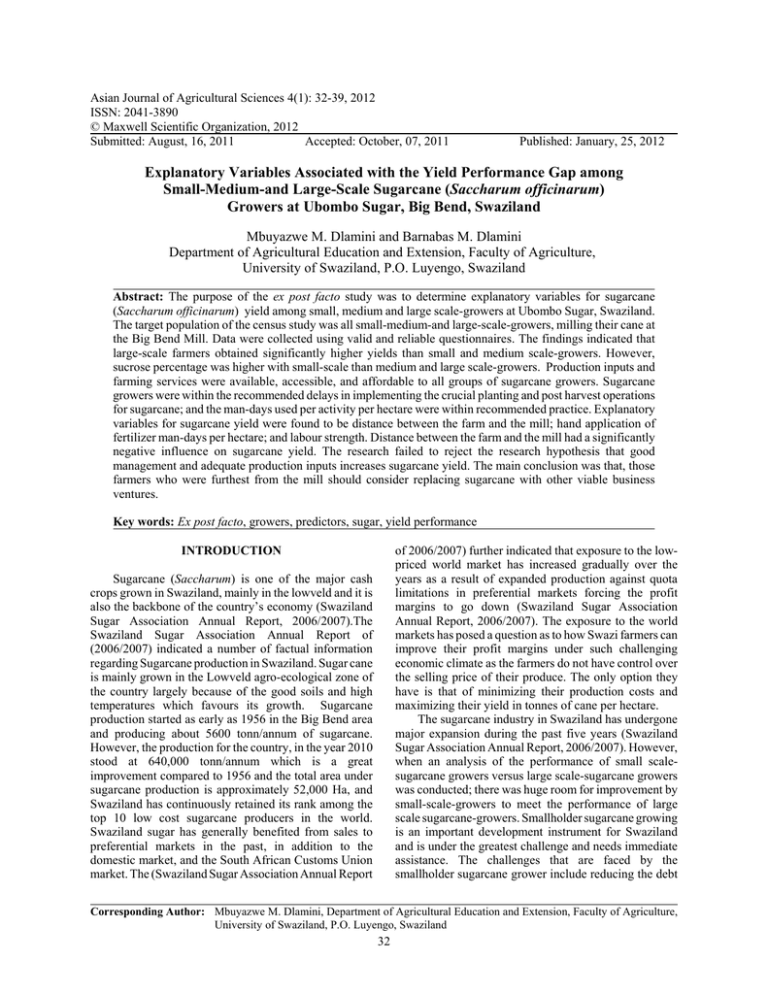
Asian Journal of Agricultural Sciences 4(1): 32-39, 2012 ISSN: 2041-3890 © Maxwell Scientific Organization, 2012 Submitted: August, 16, 2011 Accepted: October, 07, 2011 Published: January, 25, 2012 Explanatory Variables Associated with the Yield Performance Gap among Small-Medium-and Large-Scale Sugarcane (Saccharum officinarum) Growers at Ubombo Sugar, Big Bend, Swaziland Mbuyazwe M. Dlamini and Barnabas M. Dlamini Department of Agricultural Education and Extension, Faculty of Agriculture, University of Swaziland, P.O. Luyengo, Swaziland Abstract: The purpose of the ex post facto study was to determine explanatory variables for sugarcane (Saccharum officinarum) yield among small, medium and large scale-growers at Ubombo Sugar, Swaziland. The target population of the census study was all small-medium-and large-scale-growers, milling their cane at the Big Bend Mill. Data were collected using valid and reliable questionnaires. The findings indicated that large-scale farmers obtained significantly higher yields than small and medium scale-growers. However, sucrose percentage was higher with small-scale than medium and large scale-growers. Production inputs and farming services were available, accessible, and affordable to all groups of sugarcane growers. Sugarcane growers were within the recommended delays in implementing the crucial planting and post harvest operations for sugarcane; and the man-days used per activity per hectare were within recommended practice. Explanatory variables for sugarcane yield were found to be distance between the farm and the mill; hand application of fertilizer man-days per hectare; and labour strength. Distance between the farm and the mill had a significantly negative influence on sugarcane yield. The research failed to reject the research hypothesis that good management and adequate production inputs increases sugarcane yield. The main conclusion was that, those farmers who were furthest from the mill should consider replacing sugarcane with other viable business ventures. Key words: Ex post facto, growers, predictors, sugar, yield performance of 2006/2007) further indicated that exposure to the lowpriced world market has increased gradually over the years as a result of expanded production against quota limitations in preferential markets forcing the profit margins to go down (Swaziland Sugar Association Annual Report, 2006/2007). The exposure to the world markets has posed a question as to how Swazi farmers can improve their profit margins under such challenging economic climate as the farmers do not have control over the selling price of their produce. The only option they have is that of minimizing their production costs and maximizing their yield in tonnes of cane per hectare. The sugarcane industry in Swaziland has undergone major expansion during the past five years (Swaziland Sugar Association Annual Report, 2006/2007). However, when an analysis of the performance of small scalesugarcane growers versus large scale-sugarcane growers was conducted; there was huge room for improvement by small-scale-growers to meet the performance of large scale sugarcane-growers. Smallholder sugarcane growing is an important development instrument for Swaziland and is under the greatest challenge and needs immediate assistance. The challenges that are faced by the smallholder sugarcane grower include reducing the debt INTRODUCTION Sugarcane (Saccharum) is one of the major cash crops grown in Swaziland, mainly in the lowveld and it is also the backbone of the country’s economy (Swaziland Sugar Association Annual Report, 2006/2007).The Swaziland Sugar Association Annual Report of (2006/2007) indicated a number of factual information regarding Sugarcane production in Swaziland. Sugar cane is mainly grown in the Lowveld agro-ecological zone of the country largely because of the good soils and high temperatures which favours its growth. Sugarcane production started as early as 1956 in the Big Bend area and producing about 5600 tonn/annum of sugarcane. However, the production for the country, in the year 2010 stood at 640,000 tonn/annum which is a great improvement compared to 1956 and the total area under sugarcane production is approximately 52,000 Ha, and Swaziland has continuously retained its rank among the top 10 low cost sugarcane producers in the world. Swaziland sugar has generally benefited from sales to preferential markets in the past, in addition to the domestic market, and the South African Customs Union market. The (Swaziland Sugar Association Annual Report Corresponding Author: Mbuyazwe M. Dlamini, Department of Agricultural Education and Extension, Faculty of Agriculture, University of Swaziland, P.O. Luyengo, Swaziland 32 Asian J. Agric. Sci.,4(1): 32-39, 2012 burden and making loans repayable, reducing social conflict, improving productivity and efficiency and reducing costs of production (Swaziland Sugar Association Annual Report, 2006/2007). Sugarcane statistics for the past six years at Ubombo Sugar indicated a difference in yield between small, medium and largescale sugarcane growers. This gap amounts to an average of 10 tonnes of cane per ha. If this gap could be minimized by improving the performance of the smallscale sugarcane growers such that it matches that of the large-scale sugarcane growers, there would be a significant increase in overall yield. Sugarcane production is a long process that requires efficient use and proper management of different production inputs and farming services. The Swaziland Sugar Association (SSA) technical farming services noted that most of the challenges facing smallholder sugarcane growers revolved around financial and social issues. The financial and social issues have resulted into untimely or no application of agricultural production inputs such as fertilizer and herbicides and, consequently, very low yields (Swaziland Sugar Association Annual Report 2007/2008). Sifundza and Ntuli (2001) reported that smallholder sugarcane yields fluctuate more than the industry mean cane yield. These fluctuations are associated with production inputs not being affordable as well as internal disputes or changes in leadership and, to a lesser extent, climatic or environmental factors. However Sifundza and Ntuli (2001) also highlighted that there was and still room for improving yields on smallholder sugarcane farms provided small-scale farmers could be better organized in terms of accessibility to irrigation water, infrastructure, farming production inputs, co-operative harvesting associations and secondary seed cane schemes to provide healthy seed cane. According to the United Nation conference on Trade and Development (2000), access to finance is presently the biggest constraint for small-scalegrowers joining the Swaziland sugar industry. There are few institutions that lend money without collateral. Sifundza and Ntuli (2001) also observed that it was very difficult to obtain a loan for farming on Swazi Nation Land, as there is no title deed for collateral. Swazi Nation Land is land is owned by the King in trust of the Swazi Nation. The United Nation conference on Trade and Development (2000) reported that seasonal financing for crop production inputs is difficult but not impossible to achieve, provided that milling companies help by making fertilizer and herbicides where available to growers at cost, when required. Fertilizer and herbicide supply companies could also be encouraged to develop a credit system with deductions from sucrose payments. The National Adaptation Strategy for Swaziland (2006) highlighted that the major cost to the sugar industry, particularly smallholder sugarcane growers, is accounted for by transportation because of poor roads or the absence of direct routes to the mills from smallholder farms. Patterson (1998) found that professional training was crucial for growers to appropriately respond to the demand for effective performance of the sugarcane industry. Senge (1990) highlighted that farmers need to be trained on certain professional competencies for farmers to be effective. Gibson and Hillison (1994) noted that, it was crucial to devote training opportunities to those topics on which training is most important and most needed. According to Sifundza and Ntuli (2001), the limiting factor for growers is their educational background. They receive the newsletters and bulletins but many cannot read or fully understand them. Cooperatives must employ experienced managers and that the executive committees must not interfere with management of the scheme. Sifundza and Ntuli (2001) continued to argue that due to the low returns that have to be shared, some members end up seeking employment as labourers under the manager employed, and this leads to conflict of interest. Most smallholdings are established in the belief that family labour will always be available, but this is not true in most sugarcane smallholdings. The young and energetic family members prefer to go for better paying jobs in cities or industries. Those left behind are forced to employ other elderly neighbours to assist in field operations. The extension farming services provided by the government through the Ministry of Agriculture to smallscale sugarcane growers is relatively limited in terms of human resource availability and effectiveness (Sifundza and Ntuli, 2001). The SSA operates a fully fledged independent extension service managed by the sugar mills and serves the entire Swaziland sugar industry. Sifundza and Ntuli (2001) further reported that sugarcane farmers must follow the recommended input needed to maximize yield. When production inputs are adequately available, accessible, and affordable and applied on time using the correct rates, yield will respond positively. Management in sugarcane production has a huge bearing on yield (United Nation conference on Trade and Development, 2000). According to Bigman (2001), the recruitment of young, energetic and skilled labour goes a long way in ensuring that yield remains at the highest potential. Purpose and objectives of the study: The purpose of the study was to determine explanatory variables for sugarcane yield among small, medium and large-scalegrowers at Ubombo Sugar. The specific objectives of the study were to: C C C 33 Compare the differences in sugarcane yield by size of farm; small, medium and large Describe production inputs in terms of availability, accessibility and affordability to sugarcane growers at Ubombo Sugar Describe support farming services in terms of availability, accessibility and affordability to sugarcane growers at Ubombo Sugar Asian J. Agric. Sci.,4(1): 32-39, 2012 Depend Variable (DV) sugarcane Yield (mass of sugarcane weight at themill not field , after losing some moisture ) Major independent variable (MIV) Production input and management practices Rival independence variable Level of compliance to input need Training Gender Age Marital status Level of education Experience Salary level Distance from the mill Course on supervision and management Current position Size of farm in ha Timeliness in implementing the different cane production activities Man days used per activity Fig. 1: Conceptual frame work of the stud C C C C Describe the respondents by demographic variables; Describe differences in sugarcane yield by demographic variables Describe relationships among variables Identify explanatory and predictor variables of sugarcane yield Questionnaires were hand-delivered to all respondents. Frame, selection, and non response errors were controlled in accordance with suggestions by Miller and Smith (1983). An up-to-date list of all the active sugarcane growers was obtained from the cane supply manager at Ubombo Sugar, thus, controlling frame error. The list was then purged for duplications of names and for those growers who were no longer in the business of growing sugarcane, and to control selection error. The questionnaire was divided into six parts: Research hypothesis: The research was based on the hypothesis that good management practices and adequate production inputs variables increases sugarcane yield. The major and rival independent variables and the dependent variable are diagrammatically shown in Fig. 1. C METHODOLOGY C The study design was ex post facto using comparative statistics and multiple regression analysis. The study was conducted in the Lubombo region of Swaziland during the 2009 calendar year and it was a census (N = 108); therefore sampling error was not a threat to external validity of the study. The target population was all smallscale sugarcane growers (N = 76), all medium-scale sugarcane growers (N = 16) and all large-scale sugarcane growers, including the mill cum planter growing sugarcane at Ubombo Sugar mill (N = 16). Data were collected using self-administered questionnaires. C 34 Part I contained items pertaining to sugarcane yield and respondents were asked to fill in the space provided, the amount of each yield component achieved during the previous season. Part II contained items pertaining to availability, accessibility and affordability of farm production inputs and farming services. Respondents were asked to indicate their level of agreement with each item by circling the number that best reflected their opinion regarding each item by either choosing “Yes”or “No”. Part III contained items associated with time taken to conduct the different cane production activities necessary for sugarcane maximum growth. Respondents were asked to fill in the space provided the amount of time taken to conduct each activity. Asian J. Agric. Sci.,4(1): 32-39, 2012 C C C population (N = 108) that was used in this study can be considered as a sample of all the sugarcane growers in Ubombo sugar at a point in time. The results could, then, be generalized to future sugarcane growers in Ubombo sugar. This logic, therefore, permitted the use of inferential statistics in the data analysis. Part IV consisted of items pertaining to the type and amount of each input used in relation to the recommendation for maximum cane growth. Respondents were requested to fill in the space provided, the type and amount of each input used during the previous season. Part V contained items pertaining to the training of employees before engaging them to perform the different cane production activities for maximum and high quality performance. Respondents were asked to indicate whether or not their employees were trained before the respondents were engaged to perform the different cane production activities by circling the number that correspond to either “Yes” or “No”. Part VI listed items related to background and demographic variables, and respondents were asked to circle their choices or fill the information in the space provided. RESULTS AND DISCUSSION Findings: The first objective of the study was to describe sugarcane yield differences by size of farm (Table 1). The findings indicated that the large scale-growers obtained the highest yield (M = 94.66) tonnes of cane per hectare, followed by medium scale-growers (M = 88.38). The second objective of the study aimed at describing production inputs in terms of availability, accessibility, and affordability to sugarcane growers at Ubombo Sugar. The results are presented in Table 2. The overall findings indicated that the production inputs were available for use by the sugarcane growers with a frequency of 84.6%. Only 15.4% felt production inputs were not available. With regards to production inputs accessibility, the majority of the sugarcane farmers (86.6%) felt that sugarcane production inputs were readily available. The results indicated that even small growers (82.6%) agreed that production inputs are accessible and this is in agreement with the report by the United Nation conference on Trade and Development (2000) which highlighted that the necessary production inputs for the sugar industry in Swaziland are readily available in the country and, if not, can be easily sourced from South Africa without any restrictions on importation. With respect to production inputs affordability there were mixed feeling regarding the affordability of sugarcane production inputs among the sugarcane growers. The overall results indicated that only a slightmajority (63.7%) agreed that production inputs were affordable and the rest (46.3%) of the sugarcane growers felt that sugarcane production inputs were not affordable. Those who felt sugarcane production inputs were not affordable were mainly the small-scale sugarcane growers (51.1%). This is in line with the findings by Sifundza and Ntuli (2001) which highlighted that small-scale farmers do not have enough finance to adequately purchase most of the sugarcane production inputs. They also concluded that Suppliers have a tendency of supplying those growers who buy in large quantities as a result most of them even go to an extent of establishing a depot next to their major clients. The third objective of the study was to describe farming services in terms of availability, accessibility, and affordability to sugarcane growers at Ubombo Sugar. The findings are presented in Table 3. The results indicated that the majority (86.3%) of sugarcane growers felt that the required farming services in the production of sugarcane were readily available. Only 13.7% felt that A panel of experts consisting of the senior sugarcane extension officer at Big Bend, two agricultural managers from Swaziland Water and Agricultural Development Enterprise, two extension managers from SSA and three members of academic staff from the University of Swaziland were asked to review the instrument for content validity. Experts attested to the content validity of the instrument. A pilot test was conducted using cane growers who milled their sugarcane at Mhlume mill, and did not participate in the study, to determine reliability of the questionnaire. Kuder Richardson (KR 20) and Cronbach alpha procedures were used to calculate reliability coefficients of independent variables. The reliability coefficients ranged between 0.79 and 0.96. A 100% response rate was obtained. However, only 103 of the 108 questionnaires were usable, and formed the data sample for the study. Five respondents did not respond to the survey, and thus, non-response error needed to be controlled in this study. The strategy of comparing early to late respondents was used to control non-response error, using a t-test. Late respondents were surrogates to none respondents. No statistical significant differences were found between early and late respondents on the means of domains in the study. Thus, findings of the study can be generalized to the target population. The Statistical Package for the Social Sciences (SPSS) version 12 for windows was used to compute data. Descriptive statistics were used to describe data. Frequencies and percentages were used to describe respondents in terms of personal characteristics and correlations were used to describe relationships among variables. The analysis of variance and independent t-test were used to test for significant differences. Regression analysis was used to identify variables explaining and predicting sugarcane yield. An a priori probability of p#0.05 was set to determine the level of statistical significance. Though the study was a census, the 35 Asian J. Agric. Sci.,4(1): 32-39, 2012 Table 1: Differences in sugarcane yield by size of farm Cane yield (Tonnes/ha) -----------------------------------------------------------------------------------------------------------------------------------------------------Small (N = 71) Medium (N = 16) Large (N = 16) Total (N = 103) ---------------------------------------------------------------------------------Yield components M SD M SD M SD M SD F-value P-value Yield (Tonnes/ha) 86.75 20.54 88.38 24.03 94.66 19.54 88.23 20.94 0.93 0.40 Sucrose (Percent/ha) 14.16 0.67 14.03 0.51 13.86 0.56 14.09 0.64 1.5 0.22 Purity(Percent) 82.42 5.83 83.59 3.11 83.38 4.38 82.75 5.27 0.45 0.64 Cane age(Months) 12.00 1.14 11.74 1.18 12.06 0.46 11.97 1.07 0.03 0.97 Ratoons (Years) 11.61 5.15 11.63 3.03 11.31 3.30 11.56 4.60 0.45 0.64 M: Mean (Average); SD: Standard deviation Table 2: Sugarcane production inputs Production inputs domains Production inputs availability No Yes Production inputs accessibility No Yes Production inputs affordability No Yes Categorical Scale: 0: No; 1: Yes Production inputs ------------------------------------------------------------------------------------------------------------------------------------Small (N =71) Medium (N = 16) Large (N = 16) Total (N = 103) ------------------------------------------------------------------------------------------F % F % F % F % 14 57 19.8 80.2 1 15 8.5 91.0 0 16 2.3 97.7 16 87 15.4 84.6 12 59 17.4 82.6 1 15 8.0 92.1 0 16 1.1 98.9 14 89 13.4 86.6 36 39 51.1 55.1 5 14 34.1 86.0 6 13 37.5 79.7 48 66 46.3 63.7 Table 3: Sugarcane production service availability, accessibility, and affordability Service -------------------------------------------------------------------------------------------------------------------------------------------------Small(N = 71) Medium(N = 16) Large(N = 16) Total (N = 103) --------------------------------------------------------------------------------------------------Service domains Frequency % Frequency % Frequency % Frequency % Service availability No 11 15.1 2 12.5 1 8.9 14 13.7 Yes 60 84.9 14 87.5 15 76.8 89 86.3 Service accessibility No 16 22.5 1 9.0 0 1.8 18 17.2 Yes 55 77.5 15 91.1 16 98.2 85 82.8 Service affordability No 19 27.4 0 1.8 1 8.9 21 20.5 Yes 52 72.6 16 98.2 15 91.1 82 79.5 Categorical Scale: 0: No; 1: Yes such farming services were not available. The finding, however contradicted the findings by Sifundza and Ntuli (2001) who concluded that in most cases, sugarcane production farming services were not readily available to small scale-growers. Regarding cane production farming services accessibility, the majority (82.8%) of the sugarcane growers indicated that these farming services were readily accessible. A very small percentage (17.2%) viewed cane production service as not accessible. About seventy eight per cent (77.5%) of the small-scale growers agreed that farming services were easily accessible which is in agreement with the report by the United Nation conference on Trade and Development (2000). The report highlighted that production inputs and farming services in Swaziland, can be easily accessible except for the extension service which is provided by government and the Swaziland Sugar Association. The report noted that this service was relatively limited in terms of man power availability and effectiveness. The affordability of such farming services was viewed by the majority (79.5%) of respondents as affordable. Only 20.5% felt such farming services were not affordable. The fourth objective of the study was to describe the respondents by demographic variables. The findings indicated that the responding sample consisted of respondents who were male, married, and had nine years of work experience. Respondents stayed outside the Big Bend area, had secondary, or tertiary education except that the smallscale sugarcane growers had adult education and no formal school education. Respondent had taken at least one course on supervision and were working in management positions. The labour strength of the farms 36 Asian J. Agric. Sci.,4(1): 32-39, 2012 Table 4: Differences in yield by background and demographic variables of sugarcane growers Independent variables N M SD Statistics p-value Sex Female 15 90.25 24.73 Male 88 87.88 20.37 t = 0.40 0.69 Took course on supervision No 18 89.02 27.05 Yes 85 88.06 19.60 t = 0.18 0.86 Current position Manager 82 88.72 19.87 Supervisor 7 82.21 25.00 Chairman 10 85.05 17.76 Committee 4 96.70 42.83 F = 0.49 0.69 Member marital status Single 11 92.39 16.63 Married 92 87.73 21.42 t = 0.69 0.49 Home location Within big 25 91.40 21.75 Bend Outside big 78 87.22 20.72 t = 0.87 0.39 Bend M: Mean (Average); SD: Standard Deviation level of education ;delays from cane burning to thrashing and delays from cane burning to pre emergency application. The seventh objective was to determine variables that explained and predicted sugarcane yield. Multicollinearity check was conducted, before running regression analysis, using inter-correlation analysis procedures, in order to eliminate redundancy in independent variables. The results revealed high associations between the variables: input accessibility and service accessibility; delays from seed cane cutting to planting and delays from seed cane cutting to covering; delays from seed cane cutting to covering and delays from seed cane cutting to first irrigation, and between salary level and labour strength . The respective variables were combined before the regression analysis was conducted. The results of the regression analysis indicated that only one variable among the small-scale growers could explain and predict yield and, that was hand application fertilizer man days. For medium-scale growers three variables explained and predicted sugarcane yield: doing a management course, planting man days, and employee training. For large scale-growers six variables explained and predicted sugarcane yield: delays between cane cutting and first irrigation; gender; age; marital status; delays between harvesting and post-emergency application and delays between harvesting and fertilizer application. Due to the fact that there were no significant differences in yield between the three grower categories, the data for the three categories was then collapsed into one. A regression analysis was conducted for all the sugarcane growers to determine variables that could explain and predict sugarcane yield (Table 5). Three variables were found to explain and predict sugarcane yield and these variables were: distance from the farm to the mill; hand application fertilizer man days and labour strength. The total variance (R2) explained by the independent variables was 14%. Distance from the mill explained 6% of the variance in sugarcane yield with a Beta coefficient of -0.44 implying that for every1 kilometre change in distance between the mill and the farm, yield is reduced by 0.44 tonn/ha. Hand application fertilizer man days per hectare contributed 4% and labour strength for each farm explained 3.8% of the variance in sugarcane yield for all the farmers. Though labour strength contributed less, it was found to be the most important predictor of sugarcane yield as indicated by the largest beta value of 0.57 as well as the greatest impact shown by a larger t-value of 2.76 (p = 0.01). A unit change in the number of people applying fertilizer by hand per ha would improve sugarcane yield by 4.13 tonn/ha in the same direction if all other variables are held constant. If labour strength is changed by one unit, sugarcane yield would also change by 0.19 tonnes ranged from one to 50 with a mean strength of 29 people. The age of the respondents ranged between 31 and 50 years with a mean age of 46 years. The average distance of each farmer from the Ubombo Mill was 26 km, and respondents earned between US$ 72.00 and US$ 720.00 per month. The fifth objective of the study was to describe differences in sugarcane yield by demographic variables. Significant differences in sugarcane yield per hectare were determined based on background and demographic variables of respondents. Independent t-test and one way analysis of variance were used to determine significant differences. The findings are presented in Table 4. The results indicate that there were no significant differences in yield observed due to background and demographic variables. The findings imply that the background and demographic variables did not have a significant influence on sugarcane yield in tonnes cane per hectare. The sixth objective of the study was to describe relationships among variables. A very strong association was found between the following independent variables: input accessibility and service accessibility; delays from seed cane cutting to planting and delays from seed cane cutting to covering; delays from seed cane cutting to covering and delays from seed cane cutting to first irrigation , and salary had a very strong association with labour strength . A positive substantial association existed between the following independent variable: Input availability and input accessibility; input availability and service availability; input availability and service affordability; input accessibility and service availability; input accessibility and service affordability; input affordability and service availability; service availability and service accessibility; service accessibility and service affordability; sugarcane management course and highest 37 Asian J. Agric. Sci.,4(1): 32-39, 2012 Table 5: Variables explaining and predicting sugarcane yielda Independent variable R R2 R2 change B $ t -value p-value Distance of farm from the mill 0.24 5.5 0.055 - 0.44 - 0.26 - 2.75 0.00 Hand application fertilizer 0.31 1.0 0.040 4.13 0.24 2.53 0.01 Labour strength 0.37 13.3 0.038 0.19 0.57 2.76 0.01 Constant 91.1 Adjusted R2: 0.11; SE: 19.79; aCane yield: Harvested total sugarcane weight per hectare, at the mill, after a minimum growth of 12 months those farmers growing sugarcane far away from the mill to consider venturing into other viable enterprises that would give them more financial returns as opposed to sugarcane production. The results also indicated that the number of units used per given activity had an effect on yield. This was shown on labour strength and the man days for fertilizer application as predictors of yield. Sugarcane growers must therefore use the recommended units in all the sugarcane production activities. Sugarcane farmers were not well educated about the type and use of herbicides especially the small scale-growers. There is a need to conduct an intensive education drive to the sugarcane growers by the sugarcane extension workers as well as the herbicides suppliers. The results showed that the delays in the post planting activities were still high among the small-scale sugarcane growers yet such delays have a huge impact on the rate of germination and it leads to poor stalk population and size which ultimately affects yield. A need therefore arise to educate farmers on the importance of reducing the delays in post planting activities. Training of employees before being engaged was also indicated by the study as an area where most of the sugarcane growers were deficient especially the small-scale sugarcane growers. There is a need therefore to encourage farmers to always train their employees before engaging them so as to improve the quality of employee performance. cane per ha in the same direction. This implies that if a farmer increases labour strength by one unit, then sugarcane yield will increase by 0.19 tonnes of cane per hectare. Adjusted R2 was found to be 11%. Adjusted R2 measured the proportion of the variation in the dependent variable accounted for by the explanatory variables. CONCLUSION, IMPLICATION AND RECOMMENDATIONS Three independent variables: distance from the mill to the farm, hand application fertilizer mandays and labour strength of each farm could be used to explain variance in sugarcane yield, and predict level of yield in sugarcane production among sugarcane growers in Swaziland. The findings revealed that distance from the mill to the farm was explained by only 6% of the variation in yield. It further indicated that 4% of the variation in yield can be explained by hand application fertilizer man days and another 4% by labour strength for each farm. These findings imply that management and production inputs had an influence on sugarcane yield, thus, the alternative hypothesis was not rejected. Regarding the sugarcane production inputs and farming services, the study revealed that they were all available, accessible and affordable to all the sugarcane growers, irrespective of farm size. The findings therefore concurred with the report by the United Nation conference on Trade and Development (2000) which highlighted that production inputs and farming services in Swaziland can be easily accessible. Background and demographic variables did not influence sugarcane yield. Concerning the use of herbicides, the study indicated that most of the farmers were not well educated as a majority of them did not know which chemicals they had used to spray their fields. The delays in the post planting operations were still high among the small-scale sugarcane growers. The sugar industry was still male dominated by people who stay outside the Big Bend area. The study was designed to find explanatory and predictor variables of sugarcane yield variation among small, medium and large scale-growers at Big Bend. Based on the findings of the study, the findings showed that distance from the mill to each farm had an effect on yield. The further away the farm was from the mill, the lesser the yield. There is a need therefore for ACKNOWLEDGMENT Special thanks are due to the respondents: smallmedium-and large-scale sugarcane growers under the Ubombo Sugar Mill group for their timely response to the questionnaires. They were very cooperative and willing to give out information. Ubombo Sugar staff, under the department of agriculture and extension, is greatly appreciated for the support they provided to the authors during the period of study. REFERENCES Bigman, B., 2001. Sugarcane: A case as development crop in South Africa. Paper presented at the SARPN conference on land reform and poverty alleviation in South Africa. South Africa: Pretoria, 4th to 5th June 2001. Gibson, J.D. and J. Hillison, 1994. Training needs of area specialized extension agents. J. Exten, 10(2): 23-25. 38 Asian J. Agric. Sci.,4(1): 32-39, 2012 Miller, L.E. and K.L. Smith, 1983. Handling nonresponse issues. J. Exten. 22: 45-50. National adaptation strategy, 2006. In response to the EU sugar sector reforms. Swaziland Government. Mbabane, Swaziland. Patterson, T.J., 1998. Commentary II: A new paradigm for Extension administration. J. Exten 22(3): 30 -33. Senge, P.M., 1990. The Fifth Discipline the Art and Practice of the Learning Organization. Currency Doubleday, New York. Sifundza, J.T., and P.B. Ntuli, 2001. Potential of and constraints to smallholder sugarcane production in Swaziland. Swaziland Sugar Association Extension Farming services. Proceeding of the South African sugar Technologist Association congress. South Africa: Pretoria, pp: 192-195. Swaziland Sugar Association annual report (2006/2007). Mbabane, Swaziland. Swaziland Sugar Association annual report (2007/2008). Mbabane, Swaziland. United Nation conference on Trade and Development, 2000. Policies for Small-Scale Sugarcane Growing. A Report on Policies for Small-Scale Sugarcane Growing in Swaziland. Mbabane, Swaziland, Retrieved from: http:// www. unctad. org/ infocomm/ francais /sucre/doc/poitcdcom28.en.pdf, (Accessed on: July 22, 2009). 39
